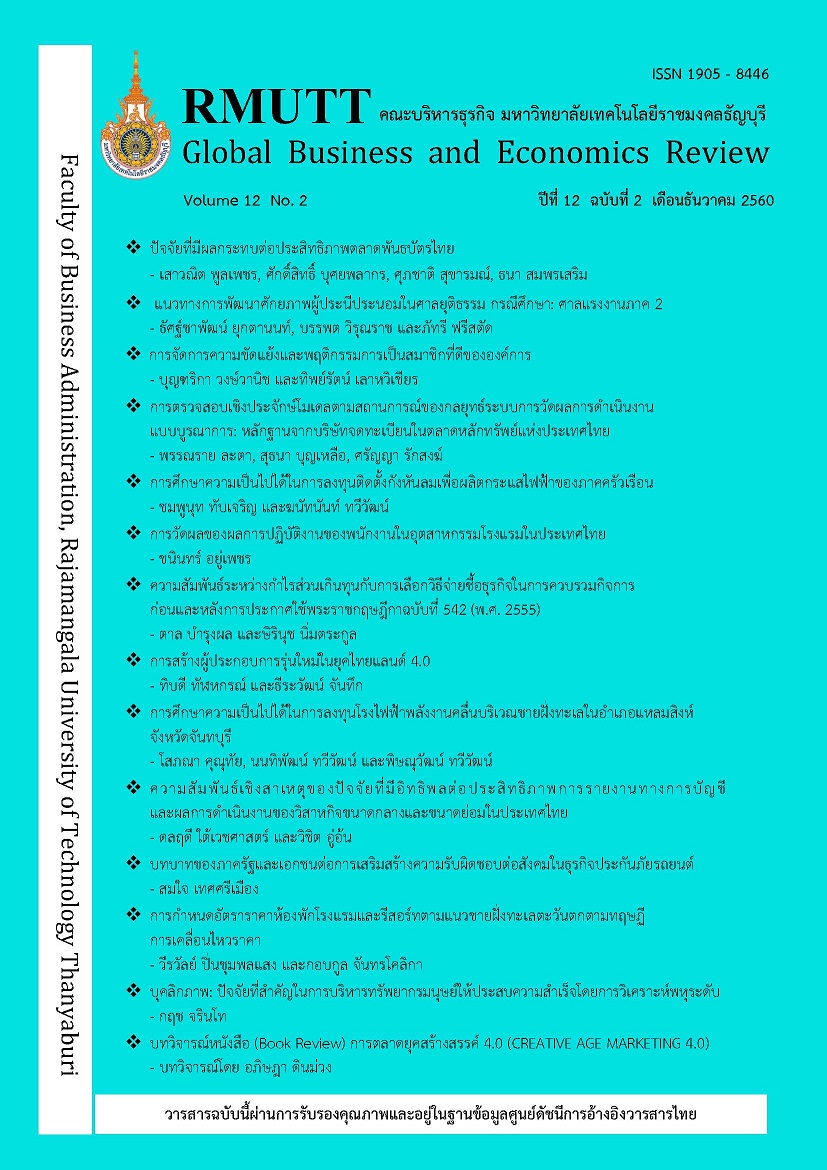FACTORS AFFECTING BOND MARKET EFFICIENCY IN THAILAND
Keywords:
Thai Bond Market, Bond, Bond Market EfficiencyAbstract
The development of bond market toward market efficiency is important because it provides a direct fundraising source for the government and private sector, providing an alternative choice for investors. This paper focuses on factors affecting bond market efficiency in Thailand by analyzing the monthly government bond data from June 2006 to December 2015, during which there was a total issue of 64 bonds series. The evidences as of this study indicate that correct reporting of bond trading information within assigned time periods can increase bond market efficiency. However, bond trading volatility, interest rate policy, and quoted bid-ask spread yield can all negatively affect bond market operational efficiency. Conversely, the net volume of purchases from foreign investors can have a positive effect. If the Thai bond market associations can improve its trading reporting procedure, information and pricing efficiency is likely to ensue. In addition, when the Ministry of Finance issues a benchmark bond series, and the Bank of Thailand issues a policy allowing financial institutions and other entities to carry out the relevant borrowing and lending transactions, the bond market will increase operation efficiency. The authorities responsible for organizing bond market development should, therefore, focus on issuing new regulations or improving existing policies in order to increase bond market efficiency. In particular, the improvement of regulations or policies in terms of reporting bond trading information should be more accurate and responsive. Furthermore, reducing transaction costs, stabilizing bond trading yield, and stimulating foreign investment in the purchase of large quantities of bonds should be paramount.
References
Aquilina, M., Butterworth, D., Suntheim, F., Winkler, C., & Ysusi, C. (2015, January, 15). Transparency in the UK bond markets: an overview. Financial Conduct Authority. Retrieved from https://ssrn.com/abstract=2885786
Bessembinder, H., Maxwell, W., & Venkataraman, K. (2006). Market transparency, liquidity externalities, and institutional trading costs in corporate bonds. Journal of Financial Economics, 82(2), 251–288.
Borio, C. (2000). Market liquidity and stress: selected issues and policy implications. Bank for International Settlements Quarterly Review, 12, 38-51.
Committee on the Global Financial System. (1999). Market Liquidity: Research Findings and Selected Policy Implications. Bank for International Settlements.
Diaz, A. & Skinner, F. S S. (2001). Estimating corporate yield curves. The Journal of Fixed Income, 11(2), 95–103.
Dow, J., & Gorton, G. (1997). Stock market efficiency and economic efficiency: is there a connection?. Journal of Finance, 52(3), 1087–1129.
Fama, E. (1970). Efficiency capital market: II. Journal of Finance, 25(2), 383-417.
Green, R., Hollifield, B., & Schurhoff, N. (2004). Financial intermediation and the cost of trading in an opaque market. (working paper). Pittsburgh, PA: Carnegie Mellon University.
Harris, L. (2003). Trading and exchanges microstructure for practitioners. Oxford: Oxford University Press.
Mares, A. (2002, August). Market Liquidity and the Role of Public Policy. Bank for International Settlements, 12.
Megginson, W. L. (1997). Corporate Finance Theory, Readin. MA: Addison-Wesley.
Merton, R. C. (1992). Continuous-time finance. Malden, Mass: Blackwell Publishers.
O’Hara, M. (1995). Market Microstructure Theory. Oxford: Basil Blackwell Publishers.
Pemberton, C. M. S., Stewart, A. L. & Watson P. K. (2005). Improving the effectiveness of the market for bonds in the CARICOM sub-region. Retrived from https://sta.uwi.edu/ salises/pubs/workingpapers/4.pdf
Samuelson, P. (1975). Optimum social security in a life-cycle growth model. International Economic Review, 16(3), 539–544.
Sarr, A. & Lybek, T. (2002, December, 1). Measuring liquidity in financial markets. Retrived from https://www.imf.org/en/Publications/WP/Issues/2016/12/30/MeasuringLiquidity-in-Financial-Markets-16211
Upper, C. (2000, February). How safe was the “Safe Haven”? financial market liquidity during the 1998 turbulences. Germany: Deutsche Bundesbank. Retrived from https://www.bundesbank.de/Redaktion/EN/Downloads/Publications/Discussion_Pap er_1/2000/2000_02_01_dkp_01.pdf?__blob=publicationFile
Woodford, M. D. (2002). Financial Market efficiency and the effectiveness of monetary policy. Economic Policy Review, 8(1), 85–94.
The Thai Bond Market Association. (2004). Retrieved September 20, 2016, from http://www.ibond.thaibma.or.th/main/govbond.html
Downloads
Published
How to Cite
Issue
Section
License
บทความที่ได้รับการตีพิมพ์เป็นลิขสิทธิ์ของผู้นิพนธ์
ข้อความที่ปรากฏในบทความแต่ละเรื่องในวารสารวิชาการเล่มนี้เป็นความคิดเห็นส่วนตัวของผู้เขียนแต่ละท่านไม่เกี่ยวข้องกับมหาวิทยาลัยเทคโนโลยีราชมงคลธัญบุรี และคณาจารย์ท่านอื่นๆในมหาวิทยาลัยฯ แต่อย่างใด ความรับผิดชอบองค์ประกอบทั้งหมดของบทความแต่ละเรื่องเป็นของผู้เขียนแต่ละท่าน หากมีความผิดพลาดใดๆ ผู้เขียนแต่ละท่านจะรับผิดชอบบทความของตนเองแต่ผู้เดียว







